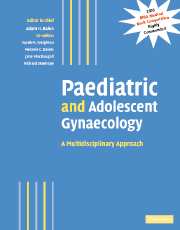Book contents
- Frontmatter
- Contents
- Contributors
- Preface
- Part I Normal development
- 1 Embryology of the female genital tract
- 2 Molecular genetics of gonad development
- 3 Gonadotrophin receptors
- 4 Normal childhood, puberty and adolescence
- 5 Control of the menstrual cycle and fertility
- 6 Nutrition and reproductive function
- 7 Normal bladder control and function
- 8 Development of sexuality: psychological perspectives
- Part II Management of developmental abnormalities of the genital tract
- Part III Management of specific disorders
- Index
- Plate section
- References
3 - Gonadotrophin receptors
from Part I - Normal development
Published online by Cambridge University Press: 04 May 2010
- Frontmatter
- Contents
- Contributors
- Preface
- Part I Normal development
- 1 Embryology of the female genital tract
- 2 Molecular genetics of gonad development
- 3 Gonadotrophin receptors
- 4 Normal childhood, puberty and adolescence
- 5 Control of the menstrual cycle and fertility
- 6 Nutrition and reproductive function
- 7 Normal bladder control and function
- 8 Development of sexuality: psychological perspectives
- Part II Management of developmental abnormalities of the genital tract
- Part III Management of specific disorders
- Index
- Plate section
- References
Summary
Introduction
Physiological and biochemical studies have established the role of gonadotrophins and their receptors in great detail in the regulation of reproductive functions. However, structural studies of genes for the gonadotrophin subunits and gonadotrophin receptors have provided reproductive endocrinologists with improved tools to study normal and pathological functions of the hypothalamic—pituitary—gonadal (HPG) axis. In this chapter, we review the current concepts of normal and pathological functions of the gonadotrophin receptors for luteinizing hormone (LH) and follicle-stimulating hormone (FSH). Amongst the most intriguing novel findings in this field are the recently discovered activating and inactivating mutations in gonadotrophin receptor genes. They corroborate and extend our knowledge of clinical consequences of gonadotrophin resistance and inappropriate gonadotrophin action. The information obtained from human mutations has been complemented by animal models with disrupted or inappropriately activated gonadotrophin ligand or receptor genes (transgenic and knockout mice). These clinical and experimental genetic disease models form a powerful tool for exploring the physiology and pathophysiology of gonadotrophin function and provide good examples of the use of molecular biological approaches to explore the pathogenesis of diseases.
LH and FSH play a crucial role in reproductive functions. Their effects on specific gonadal target cells are mediated by their cognate receptors, the LH receptor (R) and FSHR. This chapter reviews key information about structure, function and physiological and pathophysiological correlates of the gonadotrophin receptors.
- Type
- Chapter
- Information
- Paediatric and Adolescent GynaecologyA Multidisciplinary Approach, pp. 22 - 43Publisher: Cambridge University PressPrint publication year: 2004



